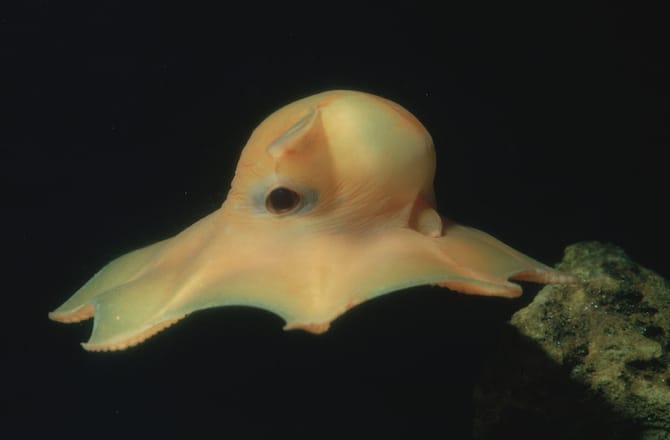

Their staring face, therefore, can be quite intimidating for their enemies who tend to be surprised and frightened if they happen to swim by one. The Flapjack Octopus has bigger, more prominent, kidney-shaped and bovine-like eyes than other species. In addition, this species lacks an ink sack, such a typical characteristic among other octopus species. The fins are one of the mechanisms it uses to successfully maneuver though the waters. The Flapjack Octopus is also distinguished from other species from the existence of fins which are similar to ears and are attached to its mantles. They are ovoid-formed, spongy, and gelatinous, with a transparent bright red, orange-red or pinkish coloration. Their size is relatively small, their mantle length can be up to 20 centimeters. Similarly to the Dumbo, the Flapjack Octopus arms are also jointed and affixed together. The Dumbo Octopus also belongs in the same category. The term umbrella octopus is used to describe the way these octopuses swim, which looks as if they were a red umbrella parachuting down the ocean. The Flapjack Octopus is a species of umbrella octopus. There is no estimation as to how many Flapjack Octopus exist. Generally speaking, this octopus species has been rarely observed and remains still understudied. But the name Flapjack Octopus has been established to refer to their ability to flatten themselves out very thin, resembling a pancake or flapjack. Flapjack Octopus expert researchers have even considered the name Opisthoteuthis adorabilis in order to describe them. They are one of the seven members of the genus Opisthoteuthis, otherwise known as ‘flapjack devilfishes’. The species was first discovered by the American marine zoologist and malacologist S.

The most notorious Flapjack Octopus is the fictional character of Pearl, an octopus in the ‘Finding Nemo’ movie. That’ s why the Flapjack Octopus has inspired so many toy makers and you can nowadays find children items in the market featuring this little orange fellow, ranging from soft toys to plush hats.

From all 300 octopus’ species, this is most probably the cutest one you’ve ever seen. We bet that every child in the world would love to adopt a Flapjack Octopus as soon as they set their eyes on them.


 0 kommentar(er)
0 kommentar(er)
